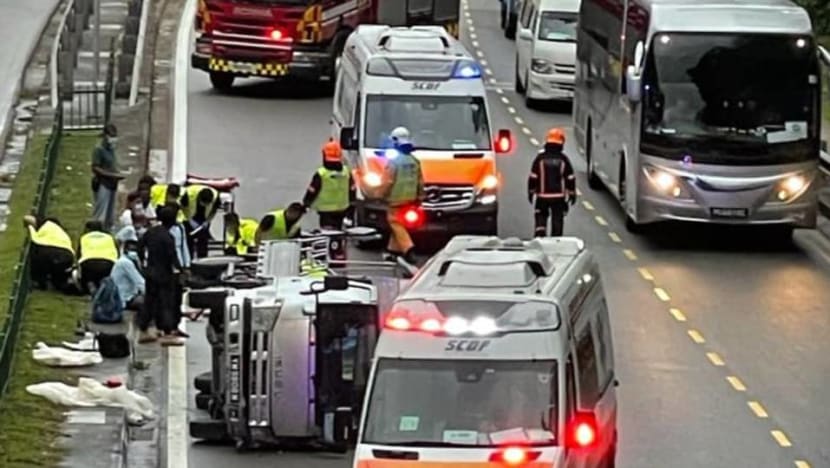Calls to review practice of transporting workers in lorries after 2 accidents

SCDF said it was alerted to the accident along Upper Bukit Timah at 7.25am on Apr 24, 2021. (Photo: 8world reader)
SINGAPORE: Rubel, a migrant worker who has worked in Singapore for 10 years, has travelled both by lorry and by bus while working in Singapore.
While he now lives at his worksite, he recalls how sitting at the back of a lorry can be "a nightmare". It was cramped and uncomfortable, and when the vehicle swerved, the workers could reel from the force.
On rainy days, workers would be drenched, even when there was a canopy on the lorry. They would usually cover themselves with large plastic bags to try to fend off the rain, he said.
"When I came to Singapore in the beginning, I used to travel by lorry. (On) rainy days, there was no shelter, even if there was shelter (it was) not able to stop the raining coming in," he told CNA.
The practice of ferrying workers by lorry is once again in the spotlight after dozens of workers were injured in two separate accidents last week.
In the accident last Tuesday (Apr 20), two workers died and 15 were injured after a collision between a lorry and stationary tipper truck along the Pan Island Expressway. Another accident on Saturday injured 10 people.
READ: 1 dead, 16 lorry passengers taken to hospital after PIE accident
Following the fatal accident, a number of people and organisations have spoken out against ferrying workers by lorry.
This is a long-standing issue that was raised in Parliament as far back as 2010, when regulations requiring the lorries to install canopies and higher side railings were implemented after a review.
Current regulations also require the drivers to go at 60kmh or slower, have a minimum space requirement for each worker and ensure that goods transported be properly secured.
While the number of accidents involving lorries ferrying workers is not tracked, statistics show that the number of accidents for lorries, tipper trucks and trailers has fallen in recent years - from 1,413 in 2015 to 1,043 in 2019.
The number of fatalities in a year range from one to eight while there were about 500 injuries a year in the same time period.
RENEWED DEBATE
More than 10 years on, the accidents have triggered debate again and raised questions about the safety of the practice. An online petition to make it mandatory to transport workers in buses or vans has got more than 8,800 supporters as of Tuesday.
Member of Parliament Alex Yam said in a Facebook post that he had raised concerns about this back in January 2012, and that the accident on Tuesday showed that the additional measures "are still insufficient for the safe transport of workers".
"I will be urging the ministry to further review suggestions made since 2010 ... to consider legislating that employers must transport their workers in mini buses or buses with compulsory seat-belting," he wrote.
"While there will definitely be additional costs to such policies but these pale in comparison to the loss of a young life who is far from home trying to earn a living for his family."
READ: PIE lorry accident: Second worker dies in hospital
Some have also asked if the drivers are getting enough rest given the long hours that they work.
In a Facebook post, non-governmental organisation It's Raining Raincoats said that it has heard reports of migrant workers who work late into the night before waking up "in the wee hours" to ferry workers.
"We have also heard that drivers may be docked wages if they are late. Given how low their wages are to begin with, the vagaries of traffic situations on our roads and the fact they these lorries run multiple trips, the drivers may be under tremendous pressure," it wrote.
Lead director of the Alliance of Guest Worker Outreach (AGWO), Samuel Gift Stephen, has been talking to employers and workers about the issue recently. He said that the transport arrangements and drivers' working hours can vary widely depending on the companies' policy.
They do have to wake up very early, but some get to rest in the middle of the day.
"If it's made mandatory and made compulsory for every guest worker to be ferried up and down to the workplace with a bus, that will be the most ideal situation ... (but) cost is going to be one big factor," he said, adding that it is harder for small companies with fewer workers to afford this.
While some have said that safety rather than cost should be a priority, Mr Stephen said making a sudden change could have unintended effects, such as the cost "trickling down" to the migrant worker.
Suggesting some alternatives, he asked if the Government could provide incentives for the companies to use buses instead of lorries.
BUSES OR LORRIES?
Mr Philip Teh, the president of the Singapore School and Private Hire Bus Owners' Association, said that larger companies, including shipyards and construction firms with health and safety policies in place, do use buses to transport workers.
For smaller firms, it can be more convenient and cost-effective to use the same vehicle to ferry both equipment and workers. Nonetheless, he said safety should be the priority.
"When there's an impact, there is no warranty of safety for them on a seat with no seatbelt or proper restraint," said Mr Teh.
READ: 10 taken to hospital after accident involving lorry along Upper Bukit Timah Road
However, Mr Jason Oh, former chairman of the Health & Safety Engineering Technical Committee of the Institution of Engineers, Singapore said that depending on the situation and risk assessment, either mode of transport can be used.
For example, if there are only a few workers going to a nearby location, it can be practical to use the lorry to transport them, and the vehicle can be used in a flexible way by the company.
"There's no perfect solution," he said. "But if you have so many workers and (the destination) so far, for example, the risk is high ... you need to get a bus," said Mr Oh.
"The regulation is basically the minimum requirement, and it makes us think whether we want to do more than the minimum."
One alternative is to still allow the use of lorries to transport workers, but add more safety features to the lorries to prevent accidents, he suggested.
Executive director of Straits Construction Kenneth Loo said that the issue should be looked at "holistically".
"One life lost is one too many ... the issue should be relooked at and (we should see) if anything can be done to improve the situation," he said.












